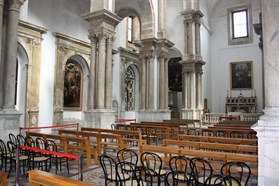The church of San Giorgio dei Genovesi in Palermo
From the first half of the fourteenth century, when the prevalence of the Guelph party in Genoa forced many Ghibellines into exile, many members of the Genoese “Nation” settled in the Kingdom of Sicily. Often engaged in public offices of great importance, or successful in businesses and in specific sectors, such as wool processing and the production of cloth, the Genoese were prominent leaders of the economy and public life in later centuries in Sicily.
 The church of San Giorgio dei Genovesi (Saint George of the Genoese) in Palermo was built between 1575 and 1596 inthe outer part of the Loggia district, close to the pier and the Senate of the city had recently decided to build to ensure the modernization of the port. On the site there was another church, dedicated to the cult of Saint Luke, which was demolished to make way for the new building. The temple was built according to a design by architect Giorgio di FaccioGiorgio di Faccio was an Italian architect, a native of Piedmont, but active in Palermo from 1559 until his death in 1592. The church of San Giorgio dei Genovesi is undoubtedly his most famous work. from Piedmont and can be considered the symbol of the power achieved by the Genoese community in Sicily in the second half of the sixteenth century, to the detriment of the traditional domination of Pisan bankers in the island. The church has a simple façade and an interior structure divided into three naves with lateral chapels: the ambition of the project and the huge amount of money it required bear witness to the wealth of the patrons. The absence of a portico, in distinction the other churches of the time, certifies to the mainly religious use of the temple.
The church of San Giorgio dei Genovesi (Saint George of the Genoese) in Palermo was built between 1575 and 1596 inthe outer part of the Loggia district, close to the pier and the Senate of the city had recently decided to build to ensure the modernization of the port. On the site there was another church, dedicated to the cult of Saint Luke, which was demolished to make way for the new building. The temple was built according to a design by architect Giorgio di FaccioGiorgio di Faccio was an Italian architect, a native of Piedmont, but active in Palermo from 1559 until his death in 1592. The church of San Giorgio dei Genovesi is undoubtedly his most famous work. from Piedmont and can be considered the symbol of the power achieved by the Genoese community in Sicily in the second half of the sixteenth century, to the detriment of the traditional domination of Pisan bankers in the island. The church has a simple façade and an interior structure divided into three naves with lateral chapels: the ambition of the project and the huge amount of money it required bear witness to the wealth of the patrons. The absence of a portico, in distinction the other churches of the time, certifies to the mainly religious use of the temple.
The interior (image) preserves marble tombstones and shrines that mirror the competition between the Genoese families of the city to obtain a prestigious space in the church of the “nation.” Among the tombstones of the various families buried there is that of the famous painter Sofonisba Anguissola. Other examples of the Baroque are the numerous paintings of the seventeenth century preserved inside the church are, in addition to an anonymous Saint George and the dragon, the Martyrdom of Saint George and the Baptism of Christ by Jacopo Palma the YoungerJacopo Negretti, known as “Palma the Younger” to distinguish him from his great-uncle Jacopo Palma “the Elder”, was an Italian painter active in the sixteenth and seventeenth century (1544-1628). A collaborator and pupil of Titian, he spent four years of training in Rome, but had great success especially in the Bergamo region in the last decades of the sixteenth century., Saint Luke Painting the Virgin by Filippo PaladiniFilippo Paladini (1544-1614) was a late-Mannerist painter from Tuscany. After a period of five years spent on the island of Malta, he lived at the court of Prince Branciforte di Mazzarino, where he died at the age of seventy. His paintings adorn many Sicilian churches in Vizzini, Palermo, Enna and Caltanissetta., the Martyrdom of Saint Vincent of Saragossa by Jacopo da EmpoliJacopo Chimenti, called Jacopo da Empoli or l’Empoli, was born and died in Florence (1551-1640). A painter who drew his inspiration from the teachers of the beginning of the sixteenth century, but also under the influence of Caravaggio, he owes his nickname to the city of origin of his father., Our Lady Queen of Genoa by Domenico FiasellaDomenico Fiasella, called Il Sarzano due to his birthplace (1589-1669), was a painter who trained in Genoa, in the workshop of Girolamo Paggi. After nearly a decade spent in Rome, where he studied ancient art, Raphael, Caravaggio and Annibale Carracci, he returned to Genoa. Here he produced most of his works, inspired by the late Mannerism and the local realism of Caravaggio. and Our Lady of the Rosary and Saints by Luca Giordano.
